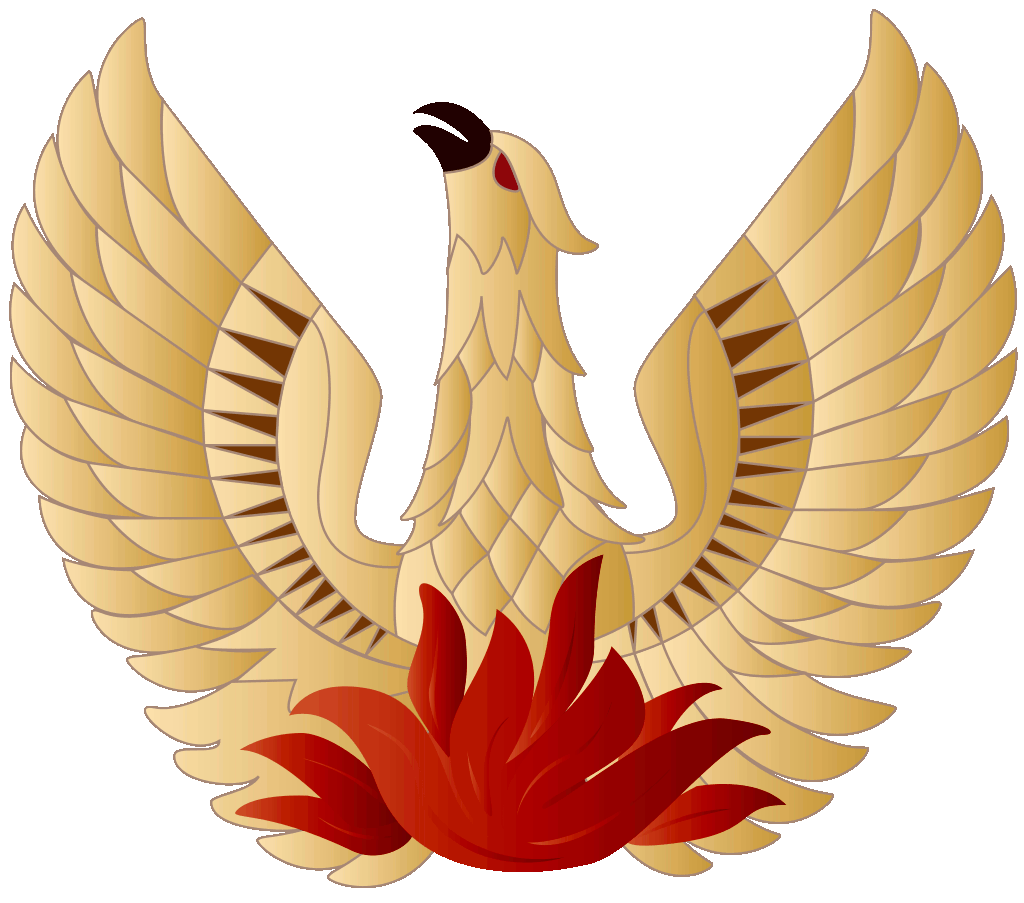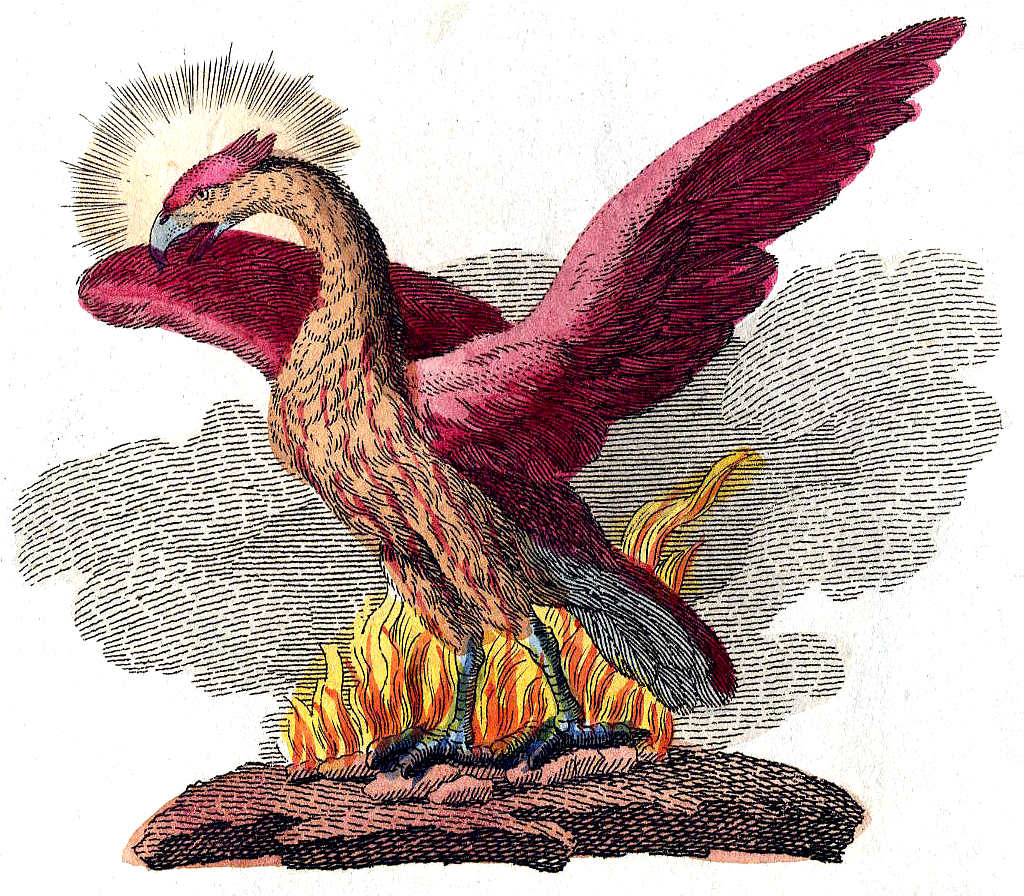|

In
this original, fictional, John Storm adventure the Red Dragon leader, General
Reza Shah, gives the name of their plot to take over the planet:
Operation Grand Slam - Phoenix. 'Grand Slam' referring to the nuclear
holocaust they are arranging, and 'Phoenix' referring to emerging from
their nuclear fallout shelters to begin again. The allies, with John
Storm leading their investigation, also use the code "Operation
Grand Slam" to refer to the defeat of the Triad cells, and
disarming of the nuclear missiles of China, Russia and the USA.
The phoenix is an immortal bird that cyclically regenerates or is otherwise born again. While it is part of Greek mythology, it has analogs in many cultures, such as Egyptian and Persian. Associated with the sun, a phoenix obtains new life by rising from the ashes of its predecessor. Some legends say it dies in a show of flames and combustion, while others that it simply dies and decomposes before being born again. In the Motif-Index of Folk-Literature, a tool used by folklorists, the phoenix is classified as motif B32.
The origin of the phoenix has been attributed to Ancient Egypt by Herodotus and later 19th-century scholars, but other scholars think the Egyptian texts may have been influenced by classical folklore. Over time, the phoenix motif spread and gained a variety of new associations; Herodotus, Lucan, Pliny the Elder, Pope Clement I, Lactantius, Ovid, and Isidore of Seville are among those who have contributed to the retelling and transmission of the phoenix motif. Over time, extending beyond its origins, the phoenix could variously "symbolize renewal in general as well as the sun, time, the Empire, metempsychosis, consecration, resurrection, life in the heavenly Paradise,
Christ, Mary, virginity, the exceptional man, and certain aspects of
Christian life". Some scholars have claimed that the poem De ave phoenice may present the mythological phoenix motif as a symbol of Christ's resurrection.
EARLY TEXTS - ANCIENT GREECE
Apart from the Linear B mention above from Mycenaean
Greece, the earliest clear mention of the phoenix in ancient Greek literature occurs in a fragment of the Precepts of Chiron, attributed to 8th-century BC Greek poet Hesiod. In the fragment, the wise centaur Chiron tells a young hero Achilles the following, describing the phoenix's lifetime as 972 times the length of a long-lived human's:
"A chattering crow lives now nine generations of aged men,
but a stag's life is four time a crow's,
and a raven's life makes three stags old,
while the phoenix outlives nine ravens,
but we, the rich-haired Nymphs
daughters of Zeus the aegis-holder,
outlive ten phoenixes."
DISPUTED ORIGINS - ANCIENT EGYPT
Classical discourse on the subject of the phoenix attributes a potential origin of the phoenix to
Ancient
Egypt. Herodotus, writing in the 5th century BC, provides the following account of the phoenix:
"The Egyptians have also another sacred bird called the phoenix which I myself have never seen, except in pictures. Indeed it is a great rarity, even in Egypt, only coming there (according to the accounts of the people of Heliopolis) once in five hundred years, when the old phoenix dies. Its size and appearance, if it is like the pictures, are as follow: The plumage is partly red, partly golden, while the general make and size are almost exactly that of the eagle. They tell a story of what this bird does, which does not seem to me to be credible: that he comes all the way from Arabia, and brings the parent bird, all plastered over with myrrh, to the temple of the Sun, and there buries the body. In order to bring him, they say, he first forms a ball of myrrh as big as he finds that he can carry; then he hollows out the ball and puts his parent inside, after which he covers over the opening with fresh myrrh, and the ball is then of exactly the same weight as at first; so he brings it to Egypt, plastered over as I have said, and deposits it in the temple of the Sun. Such is the story they tell of the doings of this bird."
In the 19th century, scholastic suspicions appeared to be confirmed by the discovery that
Egyptians in Heliopolis had venerated the Bennu, a solar bird similar in some respects to the Greek phoenix. However, the
Egyptian sources regarding the bennu are often problematic and open to a variety of interpretations. Some of these sources may have actually been influenced by Greek notions of the phoenix, rather than the other way around.
DEPICTIONS
The phoenix is sometimes pictured in ancient and medieval literature and medieval art as endowed with a halo, which emphasizes the bird's connection with the
Sun. In the oldest images of phoenixes on record these nimbuses often have seven rays, like Helios (the Greek personification of the Sun). Pliny the Elder also describes the bird as having a crest of feathers on its head, and Ezekiel the Dramatist compared it to a rooster.
The phoenix came to be associated with specific colors over time. Although the phoenix was generally believed to be colorful and vibrant, sources provide no clear consensus about its coloration. Tacitus says that its color made it stand out from all other birds. Some said that the bird had peacock-like coloring, and Herodotus's claim of the Phoenix being red and yellow is popular in many versions of the story on record. Ezekiel the Tragedian declared that the phoenix had red legs and striking yellow eyes, but Lactantius said that its eyes were blue like sapphires and that its legs were covered in yellow-gold scales with rose-colored talons.
Herodotus, Pliny, Solinus, and Philostratus describe the phoenix as similar in size to an eagle, but Lactantius and Ezekiel the Dramatist both claim that the phoenix was larger, with Lactantius declaring that it was even larger than an ostrich.
According to Pliny's Natural History,
aquilae narratur magnitudine, auri fulgore circa colla, cetero purpureus, caeruleam roseis caudam pinnis distinguentibus, cristis fauces, caputque plumeo apice honestante.
The story is that it is as large as an eagle, and has a gleam of gold round its neck and all the rest of it is purple, but the tail blue picked out with rosecoloured feathers and the throat picked out with tufts, and a feathered crest adorning its head.
—Pliny the Elder, "Naturalis historia", X: 2 — translated by Harris Rackham, 1940, LCL: 353, pp. 292–294
According to Claudian's poem "The Phoenix",
arcanum radiant oculi iubar. igneus ora
cingit honos. rutilo cognatum vertice sidus
attollit cristatus apex tenebrasque serena
luce secat. Tyrio pinguntur crura veneno.
antevolant Zephyros pinnae, quas caerulus ambit
flore color sparsoque super ditescit in auro.
A mysterious fire flashes from its eye,
and a flaming aureole enriches its head. Its crest
shines with the sun's own light and shatters the
darkness with its calm brilliance. Its legs are of Tyrian
purple; swifter than those of the Zephyrs are its wings
of flower-like blue dappled with rich gold.
—
Claudian, "Phoenix", ll. 17–22 — translated by Henry Maurice Platnauer, 1922, LCL: 136, pp. 224–225
ANALOGUES
Scholars have observed analogues to the phoenix in a variety of cultures. These analogues include the Hindu garuda (गरुड) and bherunda (भेरुण्ड), the
Russian firebird (жар-птица), the Persian simorgh (سیمرغ), the Georgian paskunji (ფასკუნჯი), the Arabian anqa (عنقاء), the Turkish Konrul, also called Zümrüdü Anka ("emerald anqa"), the Tibetan Me byi karmo, the
Chinese Fenghuang (鳳凰) and Zhuque (朱雀).[35] These perceived analogues are sometimes included as part of the Motif-Index of Folk-Literature phoenix motif (B32).
IN POPULAR CULTURE
There are many works of modern literature make reference to the phoenix,
including the two great films about an airplane that crashes in the
desert, and is rebuilt as a monoplane rescue craft, against all odds:
Flight of the Phoenix.
Other examples include:
- In Neil Gaiman's short story "Sunbird", a party of Epicureans finally answer the question of what happens when a Phoenix is roasted and eaten; you burst into flames, and 'the years burn off you'. This can kill those who are inexperienced, but those who have swallowed fire and practised with glow-worms can achieve eternal youth.
- Fawkes, a male phoenix described as Professor Dumbledore's loyal pet in the Harry Potter series.
- In Terry Pratchett's novel Carpe Jugulum, the search for the phoenix forms an important side plot.
- In Eiichiro Oda's manga and anime series One Piece, "Phoenix Marco" is a prominent character (a member of the Whitebeard Pirates) who possesses the Mythical Zoan-type Devil Fruit called the Tori Tori no Mi, Model: Phoenix, which allows him to transform into a phoenix.

The
classic depiction of a Phoenix bird rising from the flames, immortal and
reborn, again and again.
CHAPTERS
| CHARACTERS
| MEDIA
|
MOVIE REF |
SCREENPLAYS
|

